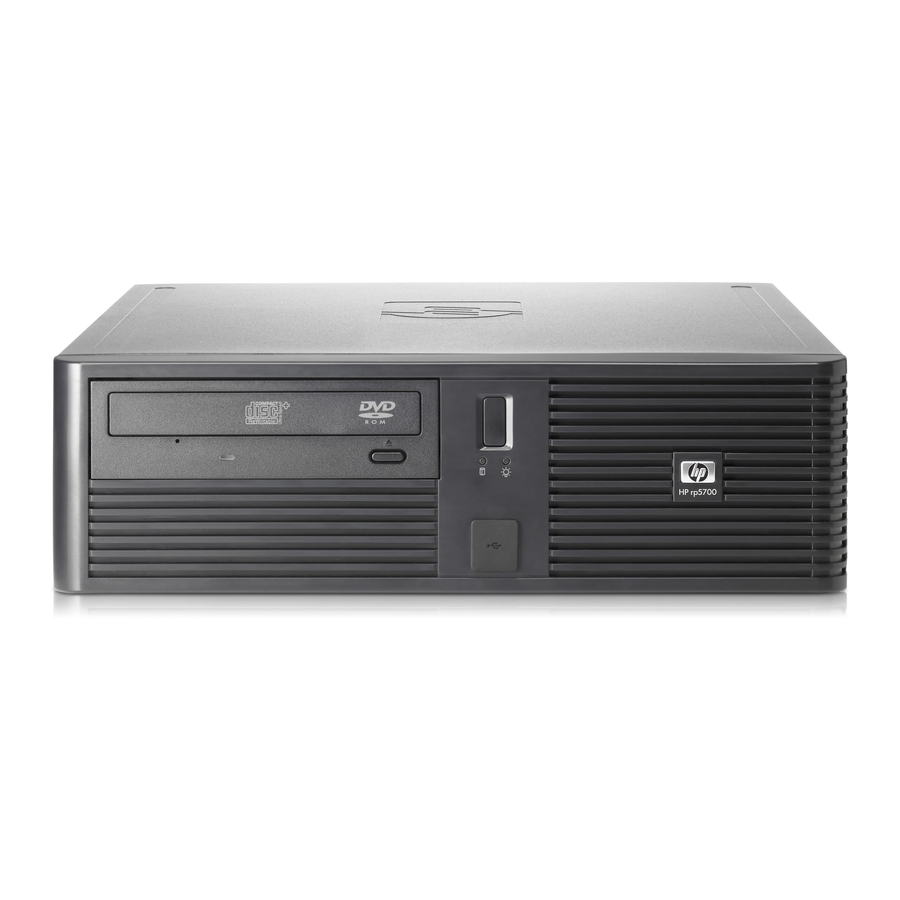
HP rp5700 Setup Utility Manual
Hide thumbs
Also See for rp5700:
- Reference manual (196 pages) ,
- Hardware reference manual (68 pages) ,
- Specification (40 pages)
Table of Contents
Advertisement
Quick Links
Advertisement
Table of Contents

Summary of Contents for HP rp5700
- Page 1 Computer Setup (F10) Utility Guide HP rp5700...
- Page 2 Nothing herein should be construed as constituting an additional warranty. HP shall not be liable for technical or editorial errors or omissions contained herein. This document contains proprietary information that is protected by copyright.
- Page 3 About This Book This guide provides instructions on how to use Computer Setup. This tool is used to reconfigure and modify computer default settings when new hardware is installed and for maintenance purposes. WARNING! Text set off in this manner indicates that failure to follow directions could result in bodily harm or loss of life.
- Page 4 About This Book ENWW...
-
Page 5: Table Of Contents
Table of contents Computer Setup (F10) Utility Computer Setup (F10) Utilities ......................1 Using Computer Setup (F10) Utilities .................. 2 Computer Setup—File ......................3 Computer Setup—Storage ....................4 Computer Setup—Security ....................6 Computer Setup—Power ..................... 8 Computer Setup—Advanced ....................9 Recovering the Configuration Settings .................... - Page 6 ENWW...
-
Page 7: Computer Setup (F10) Utility
Computer Setup (F10) Utility Computer Setup (F10) Utilities Use Computer Setup (F10) Utility to do the following: ● Change factory default settings. ● Set the system date and time. ● Set, view, change, or verify the system configuration, including settings for processor, graphics, memory, audio, storage, communications, and input devices. -
Page 8: Using Computer Setup (F10) Utilities
● Replicate the system setup by saving system configuration information to a USB flash media device or a diskette-like device (a storage device set to emulate a diskette drive) and restoring it on one or more computers. ● Execute self-tests on a specified ATA hard drive (when supported by drive). ●... -
Page 9: Computer Setup-File
Computer Setup—File Table 2 Computer Setup—File Option Description System Information Lists: ● Product name ● SKU number (some models) ● Processor type/speed/stepping ● Cache size (L1/L2) (dual core processors have this listed twice) ● Installed memory size/speed, number of channels (single or dual) (if applicable) ●... -
Page 10: Computer Setup-Storage
Computer Setup—Storage Table 3 Computer Setup—Storage Option Description Device Configuration Lists all installed BIOS-controlled storage devices. When a device is selected, detailed information and options are displayed. The following options may be presented. Hard Disk ● None (prevents BIOS data accesses and disables it as a boot device) ●... - Page 11 SATA Emulation mode is selected. For more information on RAID, see Redundant Array of Independent Disks (RAID) on dc7700 and dx7300 Business Desktops Using Intel Matrix Storage Manager at http://www.hp.com/support. Select your country and language, select See support and troubleshooting information, enter the model number of the computer, and press Enter.
-
Page 12: Computer Setup-Security
Computer Setup—Security Table 4 Computer Setup—Security Option Description Smart Card Options Allows you to enable/disable the Smart Card to be used in place of the Power-On Password. (some models) Setup Password Allows you to set and enable setup (administrator) password. NOTE: If the setup password is set, it is required to change Computer Setup options, flash the ROM, and make changes to certain plug and play settings under Windows. - Page 13 Table 4 Computer Setup—Security (continued) Network Service Boot Enables/disables the computer’s ability to boot from an operating system installed on a network server. (Feature available on NIC models only; the network controller must be either a PCI expansion card or embedded on the system board.) System IDs Allows you to set: ●...
-
Page 14: Computer Setup-Power
Computer Setup—Power Table 5 Computer Setup—Power Option Description OS Power ● Runtime Power Management— Enable/Disable. Allows certain operating systems to reduce Management processor voltage and frequency when the current software load does not require the full capabilities of the processor. ●... -
Page 15: Computer Setup-Advanced
Factory Recovery Boot Support (enable/disable). Enabling this feature will cause an additional prompt, F11 = Recovery, to be displayed during POST on systems with HP Backup and Recovery software installed and configured with a recovery partition on the boot hard drive. - Page 16 Table 6 Computer Setup—Advanced (for advanced users) (continued) Execute Memory Test Restarts the computer and executes the POST memory test. (some models) BIOS Power-On Allows you to set the computer to turn on automatically at a time you specify. Onboard Devices Allows you to set resources for or disable onboard system devices (serial port or parallel port).
-
Page 17: Recovering The Configuration Settings
Recovering the Configuration Settings This method of recovery requires that you first perform the Save to Removable Media command with the Computer Setup (F10) Utility before Restore is needed. (See Save to Removable Media on page 3 in the Computer Setup—File table.) NOTE: It is recommended that you save any modified computer configuration settings to a a USB flash media device or a diskette-like device (a storage device set to emulate a diskette drive) and save...













Need help?
Do you have a question about the rp5700 and is the answer not in the manual?
Questions and answers